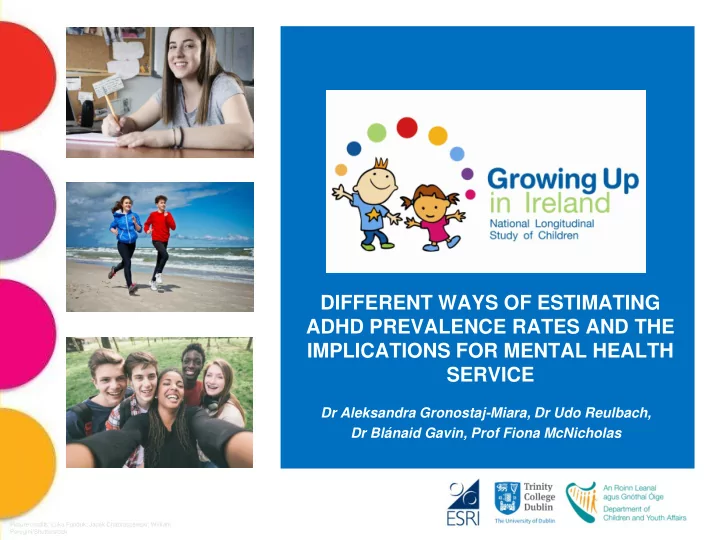

DIFFERENT WAYS OF ESTIMATING ADHD PREVALENCE RATES AND THE IMPLICATIONS FOR MENTAL HEALTH SERVICE Dr Aleksandra Gronostaj-Miara, Dr Udo Reulbach, Dr Blánaid Gavin, Prof Fiona McNicholas Picture credits: Luka Funduk; Jacek Chabraszewski; William Perugini/Shutterstock
ADHD in Irish CAMHS Attention Deficit/Hyperactivity Disorder or Hyperkinetic Disorder is a chronic behavioural disorder, characterized by symptoms of inattention, hyperactivity, and impulsivity, with onset in childhood that often persists into adulthood. It is the most frequent primary presentation to Irish Child and Adolescent Mental Health Services (CAMHS). The Fifth Annual Report of Child and Adolescent Mental Health Services (2013) notes that for 31.6% of young patients ADHD was their main aliment. 2% of children aged 5-17 years (N= 16,664) were attending CAMHS in 2012 (CAMHS report, 2013). Accurate estimates of the prevalence of mental health disorders in youth would allow for the assessment of service gap, and are critical for shaping public policy, planning, and the development of mental health services.
The prevalence of ADHD and how it’s measured “Prevalence estimates of ADHD within and between countries often vary widely” (Thomas et al., 2015) “significant variations in the prevalence rates of the disorder across continents were reported” (Canino, 2011) “Several literature reviews have reported highly variable rates worldwide, ranging from as low as 1% to as high as nearly 20% among school-age children” (Polanczyk, 2007) ADHD is the most common behavioural disorder among children. It is estimated that people. ” the condition affects 3-9% of school-aged children and young (http://www.hse.ie/eng/health/az/A/ADHD/) „ It's thought that around 2% to 5% of school-aged children may have ADHD ” (NHS Choices) The precise approximation of ADHD prevalence rate for Ireland is currently not available.
Prevalence variability sources Reasons for reported differences: geographical (Europe vs North America) -> ADHD as a product of cultural factors Increase in incidence over time Methodological differences
Different ways of asking about/measuring ADHD Methods of data collection and definitions of caseness used in research vary a single question “Has a doctor or health professional ever told you that (sample child) had attention deficit hyperactivity disorder (ADHD) or attention deficit disorder (ADD)?” (American National Health Interview Survey) validated ADHD rating scales Connors Scale, Strengths and Difficulties Questionnaire (SDQ), Child Behaviour Checklist (CBCL) clinical interviews and standardised diagnostic measures based on ICD 10 or DSM IV, V, Development and Well Being Assessment (DAWBA) Other varying factors include informants used to assess symptoms (parents, teachers, subjects) and methods of data integration (“and”, “or”, “best estimate”), examined population (age and gender), and inclusion of functional impairment
ADHD as measured in GUI Study (9 year olds) Strengths and Difficulties Questionnaire (SDQ) Indication made by primary caregiver completed by primary caregiver and teacher whether the child had ADHD with subsequent information on the A 25 item inventory with five sub-scales: emotional symptoms, hyperactivity/inattention, presence of formal diagnosis peer relationships problems, conduct problems and pro-social behaviour. 20 items form a total “Do you think the Study Child has a difficulties score Specific Learning Difficulty, Communication or Co-ordination Disorder?” Hyperactivity/inattention scale (0-10 points) Restless, overactive, cannot stay still for long “What is the nature of the difficulty or Constantly fidgeting or squirming disorder?” : a) Dyslexia (incl. Easily distracted, concentration wanders Dysgraphia, dyscalculia), b) ADHD Thinks things out before acting (Attention Deficit Hyperactivity Sees tasks through to the end, good attention span Disorder), c) Autism, d) Aspergers Syndrome, e) Speech & Language 4- fold classification: ‘close to average’, ‘slightly Difficulty, f) Dyspraxia, g) Slow progress raised’, ‘high’ and ‘very high’ scores (reasons unclear), h) Other (specify). Older 3 band categorisation: ‘normal’, ‘borderline’, and ‘abnormal’ classes “Was it diagnosed by a professional?”
GUI results – different possible prevalence estimations Parents yes/no indication: 1.4% (116 children out of 8568), including 0.83% (71) with professional diagnosis SDQ scoring: difference that cut-points make When defining ADHD caseness as reaching the threshold of top 10% of high scores (‘abnormal’ category in original classification or ‘high’ and ‘very high scores’ in current one), the change from old to new banding lowers the prevalence percentage by more than 4%.
GUI results – different possible prevalence estimations continued SDQ with new cut-points ( “close to average”, “slightly raised”, “high and very high” scores ) Parent Teacher & 2.4% 7.2% 8.1% High scores or 12.7% & 7.5% 18.6% 16.1% Raised and high scores or 26.9%
GUI findings and Irish public policy Growing Up in Ireland was not designed as an epidemiological study on youth mental health. Its findings nonetheless are informing public policy and were featured for example in ‘Better Outcomes, Brighter Futures, the national policy framework for children and young people 2014- 2020’ released in April 2014. The document states that “a significant minority of children (15% -20%) were classified as showing significant levels of emotional or behavioural problems”, repeating a statement present in Nixon’s report (2012), that averages parent’s and teacher’s assessments (“borderline” and “problematic” scores) for all SDQ subscales. Numbers obtainable form GUI on the prevalence of ADHD and its symptoms in Irish 9 year olds range from around 1% up to more than 25%, and it is vital to understand what those different numbers represent and mean.
Consequences of under- and over-estimations Underestimations Overestimations - Lack of assistance with educational - Greater immediate economical costs difficulties, problems with self- - Labelling esteem, impaired family and peer - Over-medicalization relationships, and an overall decrease in - Anchoring effect quality of life - Misdiagnosing other disorders - Lack of assistance with spillover effects for family members (impact on emotional and physical health and work productivity) - Long-term effects of untreated symptoms manifesting in occupational difficulties, criminal activity, substance abuse problems, marital discord, traffic accidents, generating long-term economical costs
THANK YOU Picture credits: Luka Funduk; Jacek Chabraszewski; William Perugini/Shutterstock
Recommend
More recommend